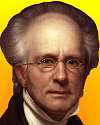 (source)
(source)
|
Rembrandt Peale
(22 Feb 1778 - 3 Oct 1860)
American artist and naturalist , son of Charles Willson Peale, who like his father was a portrait painter and naturalist who popularized the mastodon with a travelling exhibit.
|
The Gas Light Company of Baltimore
from The Chronicles of Baltimore (1874)
On the 19th of June [1816] an ordinance was passed by the Mayor and City Council, granting permission to the Gas Light Company of Baltimore to more effectually light the streets of Baltimore.
The Company obtained their charter on the 5th of February, 1817. The original corporators were Rembrandt Peale, William Lorman, James Mother, Robert Carey Long, and William Gwynn. Mr. Gwynn was then editor of the old Baltimore Gazette, and aided largely by his pen in writing the infant project into public favor.
The first building in this city lighted with gas was Peale's Museum on Holliday street, (now Old City Hall.) This was Mr. Peale's individual enterprise, and visitors paid a small fee to see the new light.
The experiment suggested the idea of lighting the city by the same means, and a charter was accordingly obtained from the Legislature, one hundred shares being set apart at the time to be assigned to Rembrandt Peale as a compensation in full for the privilege of using the invention of Doctor Benjamin Kugler of Philadelphia, for manufacturing, collecting, and using carburetted hydrogen gas.
The Company got fairly under way about 1820, its first president being William Lorman. The gas-works were located at the corner of North and Saratoga streets, and the first public building lighted with gas by the Company was tho old “Mud” or “Belvedere” Theatre, at the north-west corner of North and Saratoga streets. The first private dwelling lighted with gas was that of the late Jacob J. Cohen on North Charles street; the second, that of the late Hugh Birckhead, in the same street. From that time the consumption of gas steadily increased, until, instead of the three original takers in 1820, there were, in 1870, 15,301 consumers of gas in the city. Besides this, the Company also supplies 3400 city-lamps for lighting the streets.
[In a later book by the same author, in History of Baltimore City and County (1881), most of the above information was incorporated in a much longer article. There were some changes in the revision, including that 17th June 1816 was given as the date the ordinance was passed. The sentence about Mr. Gwynn's writing in the Gazette was omitted. The owner of the first private dwelling's owner was given as Jacob I. Cohen. A link to this newer article is given below.]
- Science Quotes by Rembrandt Peale.
- 22 Feb - short biography, births, deaths and events on date of Peale's birth.
- The Gas Light Company of Baltimore - lengthy description from History of Baltimore City and County (1881).
- Booklist for Rembrandt Peale.




